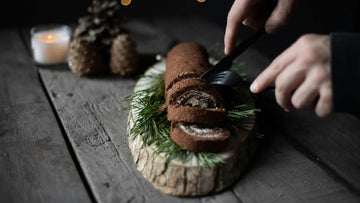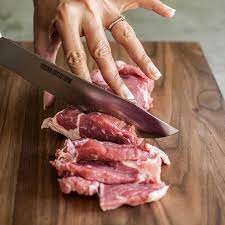The Ultimate Showdown Bamboo Cutting Board vs Wood
by Jerry Barker on Dec 19, 2023

The issue of choosing an ideal cutting board in your kitchen always involves the bamboo versus wood argument. Therefore, this makes the choice of either material a little hard as each one has its strengths and weaknesses.
We examine the special qualities of the bamboo and wooden chopping boards, contrast them, look out for its strength, management as well as ecological effect in order to enable you chose the most appropriate for the kitchen activities.
A cook’s kitchin needs to be equipped with one or more of those appliances since it could make a difference whether you are a chef or just an enthusiastic cook.
Knowing the differences between the two cutting boards.
Selecting an appropriate cutting board is an essential factor when it comes to your kitchen. It’s good to know the difference between Bamboo and wood.
They are considered as eco-friendly because they are created using bamboo which is a renewable and a sustainable resource.
Furthermore, they are well-known because of high durability and ability to withstand water, thus are preferred in most homes. However, wooden cutting boards including ones from maple and walnut have a traditional look and feel to them.
These knives are also very durable and can be used for a long time without getting damaged or losing its sharpness.
The durability of bamboo cutting boards is a big plus. Bamboo is a tough material with high density, which makes bamboo cutting boards less exposed to the knife marks and scratches like in the case of the wooden boards.
This is because the inherent nature of bamboo results in a lesser probability of twisting and splitting hence offering a durable counter top for chopping purposes. Bamboo also resists moisture, thus minimizing bacterial and mould developments during food preparation, hence being hygienic.
Wood cutting:
However, wood cutting boards come in a variety of woods giving them different colours and grains. For instance, maple cutting boards have a light colour with fine grain while walnut cutting boards has dark colour along with strong grain pattern.
Due to these factors, wooden cutting boards are favored by most home cooks who do not want to have an ugly looking kitchen. On top of that, wood possesses inherent antibacterial qualities that prevent microorganisms from forming on the cutting board’s surface.
Comparison: Bamboo Cutting Board vs. Wood:
Durability:
While there is certainly nothing wrong with these materials when it comes to sturdiness, bamboo is more durable than wood.
Indeed, bamboo is known for its exceptional strength and hardness making it a suitable material in making the chopping blocks or cutting boards which are commonly referred to as chopping blocks or cutting boards.
They are not easily affected by knife marks and scratches making them durable and strong enough to give you long lasting service.
Also, wood cutting-boards (especially hard maple or walnut) are extremely durable and will stand up every-day abuse. With proper care and maintenance, wooden or bamboo cutting boards are likely to maintain their pristine state even after several years.
Color and Grain:
A cutting board should look good in terms the overall beauty of the kitchen which is very important. Most bamboo cutting boards tend to have a light and uniform colour with delicate streaks giving a sleek modern appearance.
However, different woods such as maple and walnut are available in light, creamy and dark colors for cutting surfaces..
Wood provides natural elegance to the kitchen through its unique grain patterns that have made it a favorite material for making wood cutting boards.
Maintenance:
Whether it is a bamboo or wood cutting board, proper maintenance will prolong its life. It is imperative for you to maintain and clean Bamboo cutting boards regularly by rinsing them using very mild soap and water and oiling occasionally to ensure that the bamboo remains hydrated to avoid drying up completely.
.Regular cleaning and oiling of wood cutting boards also help them to maintain their beauty and not absorb moisture. All cuts should be allowed to air dry after cleaning; then they should be kept in a dry, ventilated place to avoid warping and cracking.
Cost:
Bamboo cutting boards are usually cheaper compared to wooden ones. Given its durability, bamboo is another affordable material one can use to make cutting boards.
Hardwood woodboard that is properly crafted with quality workmanship is a little costly because of its natural worth and therefore not affordable to many people, especially to students.
Even though the initial cost is high, wooden cutting board will last for a long time and has timeless beauty for a kitchen.
Advantages and disadvantages of bamboo cutting boards.
They are made out of bamboo which has superior strength making them long lasting;
they also do not absorb water as compared to the wood ones and being a renewable product;
it is natural environment friendly. These pans are also highly portable since they can be easily handled and moved around for convenience when used daily at home or within the confines of the kitchen.
Bamboo, however, is easily cut through by a sharp knife and needs to be oiled once in a while for maintenance purposes.
Advantages and Disadvantages of Using Wood Cutting Board:
Classic and timeless look of wood cutting board are one more reason why they are so popular among cooks nowadays; they have natural anti-microbial qualities that prevent from the further development of bacteria.
The company produces a variety of wood types, color and grain pattern for one can purchase the cutting board that matches with his/her kitchen décor.
Wood cutting boards may also need regular oiling and sanding in order not to let moisture damage them.
Maintenance and Care for Bamboo Cutting Boards:
To ensure the longevity of your bamboo cutting board, it is essential to follow proper maintenance and care guidelines.
Regular cleaning with mild soap and water, as well as air-drying after use, will help keep your bamboo cutting board in top condition.
Additionally, applying a food-safe mineral oil or bamboo cutting board oil every few months will help prevent the bamboo from drying out and cracking.
Bamboo is highly responsive to excessive heating and water, which may result in significant damages including warping of the board.
Maintenance and Care for Wood Cutting Boards:
Just like wood cutting boards, they need a considerable amount of care and maintenance to maintain their natural beauty as well as functionality.
A cleaning with mild soap and daring must be done, so bacteria and mold do not grow on it.
It is advisable to apply a food–grade mineral oil or a cutting board oil every few months to keep the wood hydrated and moist free.
Another process that can be employed is sanding the surface of the wood cutting board to ensure that the rough areas are eliminated and the smooth texture maintained for food preparation.
Hygiene and Safety Considerations:
The preparation of food zone must be clean and free from any contamination to ensure any kitchen is safe. Thus, as long as you keep your cutting board’s Bamboo or wood clean then it will also remain hygienic.
Wood is naturally antimicrobial, which would prevent the multiplication of bacteria, whereas bamboo cutting board resists water and is therefore more hygienic.
The cutting boards should be used for raw meats, poultry, and fish separately; they should also be cleaned and sanitized often.
Environmental Impact of Bamboo vs. Wood Cutting Boards:
The sustainability and renewal factor of bamboo make them preferable when talking about the environmental impact of cutting boards.
Bamboo is a sustainable source of timber because it grows quickly but does not harm the plant while it is being harvested.
However, wood cutting boards are mostly sourced from hardwood trees that require several years of growth before being harvested.
Hence, wood cutting boards made out of responsibly harvested and sustainably certified woods would be beneficial in reducing environmental issues associated with them.
The growth of bacteria and other pathogenic microorganism should be contained by a good cutting board among other things.
Likewise, both bamboo and wood cutting boards have natural antimicrobial characteristics which allow them to remain as a clean surface.
Bamboo has a high density and natural antibacterial. Certain types of wood like maple or walnut have antibacterial elements. ```
Bamboo Cutting Board vs. Wood: Which One Should You Buy?
In summary, you have to choose a wooden or bamboo cutting board depending on your preferences for use and maintenance costs.
A cutting board made of bamboo will be right for the people who value sustainability and their environmental friendliness.It offers durability, is resistant to water; and also, it is considered as an environmentally friendly choice.
However, if you like the natural beauty of wood and an array of choices when it comes to grain and colour, wooden cutting boards should definitely become integral part of your kitchen kit. You ought to take into account matters like repairs, price, and beauty.
FAQs:
Do bamboo cutting boards outperform wood cutting boards?
As such, both bamboo and wood cutting boards come with their own benefits, depending on what you would want to accomplish. Bamboo cutting boards demonstrate longevity and eco-friendliness, while wooden cutting boards radiate tradition.
Do bamboo cutting board make dull knives?
Tmnnt bamboo cutting boards are knife friendly since the denseness of bamboo maintains a knife’s sharpness. Similarly, as with any chopping board bamboo chopping boards will acquire knife marks with frequent usage.
What is the procedure for keeping a bamboo chopping board? .
Bamboo cutting boards are easy to maintain by washing them using mild soaps, allowing them to dry thoroughly and applying bamboo cutting board oil or some kind of edible mineral oil once in every month.
Which kind of wood works well in making a cutting board? .
Wood cutting boards made out of hardwoods like maple, walnut and cherry are preferred since they are strong and naturally possess microbial properties. Strongest with aesthetic beauty, yet these woods are ideal for cutting and using as food preparation wood.
Conclusion:
The bottom line of bamboo versus wooden chopping boards is that they all compete for users’ tastes because both have their strengths. Bamboo cutting boards are noted for being long lasting, environmentally friendly, and resistant to wOn onater which makes them valuable and environmental considerate board to use in the kitchen.
Unlike wooden cutting boards that appeal to people desiring the feel of a wood based in kitchen setting, traditional wooden cutting boards have antimicrobial properties which make them unique.
Bamboo or wood are good options as long as you provide regular maintenance and care so it continues being a hygienic and trustworthy utensil in this respect.ҽ First, keep in mind what is important, what you like and any concern over environmental issue in choosing a cutting board that would fit perfectly in your kitchen.



